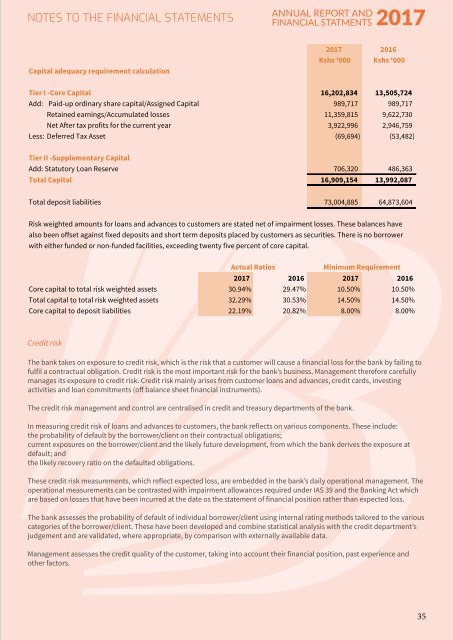BOB_2017_SMALL
You also want an ePaper? Increase the reach of your titles
YUMPU automatically turns print PDFs into web optimized ePapers that Google loves.
NOTES TO THE FINANCIAL STATEMENTS<br />
ANNUAL REPORT AND<br />
FINANCIAL STATMENTS <strong>2017</strong><br />
capital adequacy requirement calculation<br />
<strong>2017</strong> 2016<br />
kshs '000 kshs '000<br />
tier i -core capital 16,202,834 13,505,724<br />
Add: Paid-up ordinary share capital/Assigned Capital 989,717 989,717<br />
Retained earnings/Accumulated losses 11,359,815 9,622,730<br />
Net After tax profits for the current year 3,922,996 2,946,759<br />
Less: Deferred Tax Asset (69,694) (53,482)<br />
tier ii -Supplementary capital<br />
Add: Statutory Loan Reserve 706,320 486,363<br />
total capital 16,909,154 13,992,087<br />
Total deposit liabilities 73,004,885 64,873,604<br />
Risk weighted amounts for loans and advances to customers are stated net of impairment losses. These balances have<br />
also been offset against fixed deposits and short term deposits placed by customers as securities. There is no borrower<br />
with either funded or non-funded facilities, exceeding twenty five percent of core capital.<br />
actual ratios<br />
minimum requirement<br />
<strong>2017</strong> 2016 <strong>2017</strong> 2016<br />
Core capital to total risk weighted assets 30.94% 29.47% 10.50% 10.50%<br />
Total capital to total risk weighted assets 32.29% 30.53% 14.50% 14.50%<br />
Core capital to deposit liabilities 22.19% 20.82% 8.00% 8.00%<br />
Credit risk<br />
The bank takes on exposure to credit risk, which is the risk that a customer will cause a financial loss for the bank by failing to<br />
fulfil a contractual obligation. Credit risk is the most important risk for the bank’s business. Management therefore carefully<br />
manages its exposure to credit risk. Credit risk mainly arises from customer loans and advances, credit cards, investing<br />
activities and loan commitments (off balance sheet financial instruments).<br />
The credit risk management and control are centralised in credit and treasury departments of the bank.<br />
In measuring credit risk of loans and advances to customers, the bank reflects on various components. These include:<br />
the probability of default by the borrower/client on their contractual obligations;<br />
current exposures on the borrower/client and the likely future development, from which the bank derives the exposure at<br />
default; and<br />
the likely recovery ratio on the defaulted obligations.<br />
These credit risk measurements, which reflect expected loss, are embedded in the bank’s daily operational management. The<br />
operational measurements can be contrasted with impairment allowances required under IAS 39 and the Banking Act which<br />
are based on losses that have been incurred at the date os the statement of financial position rather than expected loss.<br />
The bank assesses the probability of default of individual borrower/client using internal rating methods tailored to the various<br />
categories of the borrower/client. These have been developed and combine statistical analysis with the credit department’s<br />
judgement and are validated, where appropriate, by comparison with externally available data.<br />
Management assesses the credit quality of the customer, taking into account their financial position, past experience and<br />
other factors.<br />
35




